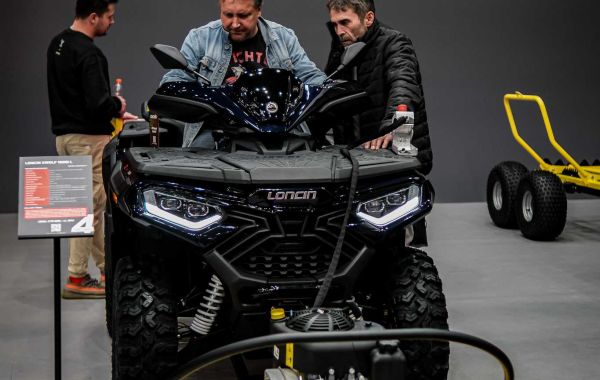Determine the Purpose of Use
- Recreation: If you plan to use the ATV for trail riding, exploring nature, or off-road adventures, sport ATVs would be a good choice. They offer agility, speed, and responsive handling, providing an exciting riding experience. For example, the Coleman Powersports AT200R excels in ground clearance, suspension systems, and all-terrain tires, making it suitable for tackling rough trails.
- Utility: For tasks like transporting goods on farms, ranches, or construction sites, or for lawn care and landscaping, utility ATVs are more appropriate. These ATVs prioritize power, durability, and cargo capacity, often featuring cargo racks, winches, and towing capabilities. The RPS Utility ATV 200cc is a reliable option.
- Hunting and Fishing: ATVs can help transport hunting and fishing gear and assist in tracking game. When selecting an ATV for hunting, consider features like quiet operation and good off-road performance.
- Snow Removal: If you need to clear snow in winter, choose an ATV equipped with a snow plow attachment. Some ATVs are specifically designed for snow removal tasks.
Consider Engine Size and Power
- Beginners: For new riders, ATVs with smaller engines, such as those between 50cc and 200cc, are recommended. These models offer manageable power and gentle handling, providing a safe learning curve to build confidence and skills.
- Intermediate Riders: Riders with some experience can opt for ATVs with engine sizes ranging from 200cc to 500cc. These provide a balance of power and maneuverability, suitable for tackling varied terrains.
- Advanced Riders: For experienced riders who intend to navigate challenging terrains or engage in high-speed activities, ATVs with engines of 500cc or higher are ideal. These deliver greater power and speed to meet the demands of complex riding conditions.
Choose Transmission Type
- Automatic Transmission: Automatic ATVs are easy to operate, requiring no gear shifting, which makes them ideal for beginners or those who prioritize convenience and comfort.
- Manual Transmission: Manual transmission ATVs offer greater control over gear shifting, allowing riders to adjust gears according to terrain and riding conditions. They are better suited for experienced riders tackling demanding trails.
- Semi-Automatic Transmission: Semi-automatic transmissions combine the advantages of automatic and manual transmissions. Riders can choose between automatic mode for simplicity or manual mode for enhanced control.
Assess Suspension and Tires
- Suspension: The suspension system significantly impacts riding comfort and control. If you plan to ride on rough trails with obstacles like rocks and roots, advanced suspension systems, such as long-travel suspension or high-performance shocks, can better absorb impacts and reduce rider fatigue.
- Tires: Select tires based on the terrain. For example, mud tires feature deep treads for better grip in mud; sand tires have wide, flat treads to prevent sinking in sand; all-terrain performance tires offer a balance of off-road and on-road capabilities; while hard-packed trail tires are suitable for relatively smooth trails.
Define Your Budget
- Entry-Level ATVs: Entry-level ATVs typically cost a few thousand dollars and meet basic riding needs. These models are relatively simple in design and features but still provide a fun riding experience.
- Mid-Range ATVs: Priced between $5,000 and $10,000, mid-range ATVs offer improved performance, suspension, and comfort features, making them suitable for most riders.
- High-End ATVs: High-end ATVs can cost over $10,000 and feature powerful engines, advanced suspension systems, premium components, and cutting-edge technologies. They deliver superior performance and riding comfort but come with a higher price tag.
Evaluate Vehicle Size and Comfort
- Ensure the ATV's size matches your body proportions. Consider seat height and handlebar position to ensure comfortable control and operation. Test-riding different ATVs can help determine which model suits you best.
Consider Technology and Accessories
- Modern ATVs come equipped with various technologies. For instance, GPS and navigation systems enhance off-road exploration; multi-functional digital displays provide real-time information like speed and fuel level; Electronic Power Steering (EPS) reduces steering effort; traction control and stability systems improve control; and Bluetooth and smartphone integration enable hands-free communication. Additionally, accessories such as cargo racks, winches, plows, and gun racks can expand the ATV's utility.
Prioritize Safety Features
- Look for safety features such as headlights, safety kill switches, speed limiters, roll-over protection systems (ROPS) for side-by-sides, anti-lock braking systems (ABS), and traction control. These features can enhance riding safety, especially for beginners or younger riders.
Research Brands and Models
- Research different ATV brands and models, such as Honda, Yamaha, Polaris, Can-Am, Kawasaki, and Suzuki. Each brand has its own advantages and characteristics. For example, Honda is known for durable engines and low maintenance; Yamaha offers excellent build quality and handling; Polaris stands out for power and innovation. Read user reviews and seek recommendations from friends or fellow riders to gain a better understanding of various brands and models.
Legal and Regulatory Requirements
- Familiarize yourself with local laws and regulations regarding ATV use, including age restrictions, licensing and registration requirements, helmet laws, and designated riding areas. Ensure compliance with legal standards to avoid penalties and ensure safe riding.
Maintenance and Warranty
- Consider the cost and effort required for regular maintenance, such as oil changes, air filter replacements, tire rotations, battery maintenance, and brake inspections. A good warranty can provide peace of mind and reduce potential repair costs. Compare warranty terms and service networks across different brands and models.
Here is a summary of common ATV types and their features:
| ATV Type | Features | Suitable For |
| Sport ATVs | Streamlined design, high-power engines, emphasis on speed and handling, relatively light weight, but smaller cargo space | Recreational activities like trail riding and racing |
| Utility ATVs | Robust build, powerful engines, large cargo racks and towing capacities, comfortable seats, often equipped with reverse gear | Farming, ranching, landscaping, snow removal, and other work-related tasks |
| Youth ATVs | Compact size, smaller engines, low speeds, simple operation, equipped with safety features like speed limiters | Children and teenagers under 16 for light trail riding and recreational use |
| Side-by-Side (UTV) | Car-like features, multi-passenger seating, comfortable rides, capable of carrying heavier loads | Group outings, work transport, and leisure activities |
When selecting an ATV, it is advisable to visit a dealership for a test ride to experience the vehicle's handling and comfort firsthand. Based on your needs and preferences, choose the model that best suits you.








